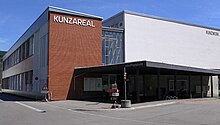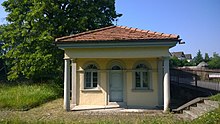Kunz spinning mill
In the 19th and 20th centuries, the Kunz spinning mill was a large textile company for the production of cotton yarn in the municipality of Windisch in the Swiss canton of Aargau on the Reuss . The technology- and architectural history valuable architectural ensemble is one of the cultural heritage of national importance and constitutes a portion of the industrial culture path at the water tower . Today the former industrial site is a real estate development area under the name Kunzareal .
Location
The water power of the Reuss served below the old, important river crossing between Windisch and Gibstorf since the Ancien Regime, thanks to the steep gradient there, several waterworks: On the left side of the Unterwindisch settlement there had been a sawmill, a Lohstampfe , a gypsum mill and one since around 1790 Oils . A close-built on the left bank of Reuss weir led a small portion of the river to their water wheels. On the right-hand side there was a grain mill with its own partial weir near Gibstorf. All of these systems were replaced by the spinning complex.
founder
The textile entrepreneur Heinrich Kunz (born March 1, 1793 in Oetwil am See ; † August 21, 1859 in Uster ), who had founded spinning mills in Schaffhausen , Wetzikon and Uster since 1811 , bought the industrial area in Windisch in 1828 and helped to build a multi-part industrial landscape there Power station and double weir and large spinning mill buildings in a monumental classicist design.
By 1845 Kunz bought further spinning mills in Adliswil , Linthal , Rorbas and Kemptthal . With around 150,000 spindles in his operations, he was considered the largest spinning mill entrepreneur beyond Switzerland. What has been handed down, however, is a reckless behavior of Heinrich Kunz towards the workers in his factories, which has often been put on record.
Factory history
On December 29, 1827, the municipal assembly of Windisch approved the sale of the commercial quarter in Unterwindisch to Heinrich Kunz, who on August 4, 1828 received the water right concession from the canton of Aargau to build a cotton mill on the Reuss. Heinrich Kunz bought the Reussmühle with its water rights from Johann Hartmann, the miller fromhabenstorf, and closed this operation. By 1829 and 1835 he had the two symmetrically laid out, six-story factory buildings built, each with an undershot waterwheel on both sides of the canal (today called the "old spinning mill").
In 1828, the Great Council of the Canton of Aargau approved the Kunz spinning mill to be able to take the workers from Gibstorf directly to the factory across the Reuss with its own ship, which shortened the commute by half an hour. But because many workers lived in the opposite village, soon only a small number of them could get directly to the factory in this way. That is why the canton approved the construction of a footbridge in 1834. The light wooden bridge was demolished in 1916 and replaced by a concrete bridge.
Because of the large river structures at the new factory, there were violent arguments for years. On the one hand, the boatmen and raftsmen on the Reuss defended themselves against the new obstacle to the river, which faced them with a dangerous passage in the waterway, and on the other hand, the cantonal authorities initially refused to accept the weir system , which did not fully meet the conditions of the water rights concession . After several negotiations, the canton of Aargau finally granted Heinrich Kunz a new, more generous concession in 1840. The river shipping complaints had been ineffective. The factory was now allowed to drain all the water from the Reuss into its works canal even when the water level was low. Incoming ships, however, still had to be guided free of charge through the lock next to the stretcher weir, which was already prescribed by the canton and was completed in 1835 . When the water level was normal, there was still a narrow passage open for rafts in the middle of the river between the two lateral weirs into the stilling basin .
Around 1829 a small factory owner's villa was built next to the spinning mill in Windisch, and from 1837 the company built its first own residential building on Kanalstrasse for employees. By the end of the 19th century, 10 workers' houses ("Kosthäuser") and houses for employees were added in Unterwindisch and Gibstorf.
The manor house, which was built together with spinning mill 1, which was completed in 1829 and is attached to its southern narrow side, was built as a residence for Heinrich Kunz. The villa-like building presents itself as a classical structure with a gently sloping hipped roof surrounded by a balustrade. In terms of structure and window details, the manor house is very similar to the former guard house (later a factory school). It should have been created by the same builder.
Around 1830, the so-called watchman's house was built around the banks of the Reuss, a small one-story building right next to the pedestrian bridge. The building, designed in the classical style, has a square floor plan and a column-supported porch. The 3 m by 3.9 m house served as a factory school since 1838 . It is the only example of this type of building preserved in Aargau. Since 1828 the manufacturers were obliged by law to set up private schools and to give lessons to the children they employed for at least six hours a week.
After the founder's death in 1859, his nephews Heinrich Zollinger and Johannes Wunderli-Zollinger continued to run the company. They acquired other spinning mills in Eastern Switzerland by 1880 and, with a machine park of 245,000 spindles and around 2,700 employees, they were among the largest employers in the Swiss textile industry. In Windisch, thanks to additional drive energy, they were able to build an even larger factory (today the “New Spinning Mill”) next to the older buildings in 1870. In 1865 they had increased the available hydropower by replacing the water wheels with four Jonval turbines from Escher, Wyss & Co. and extending the factory canal to over a kilometer. Only shortly before the Reuss flows into the Aare in the area of the moated castle , at the bridge of the Brugg - Baden railway line of the Swiss Northeastern Railway , built in 1856 , does the canal water flow back into the Reuss.
The company, which has been active since 1893 as Wunderli, Zollinger & Cie., Formerly Heinrich Kunz , was converted into a stock corporation in 1898, the AG der Spinnereien von Heinrich Kunz . In the years 1907 to 1908, the company completely rebuilt the company. In addition to the hydroelectric power plant, a steam power plant was built for the production of its own electrical energy, and the factory buildings now only had four floors.
In 1912, the textile group W. Wolf & Sons in Stuttgart acquired the shares in the Kunz spinning mill with the four factories of Linthal, Windisch, Rorbas and Adliswil still belonging to the company. In 1917 the new owner built the representative administration building that is still preserved today in Unterwindisch. On the factory canal, the company built a new turbine house with a propeller turbine, and with the conversion of the barrier from the old needle weir to an iron weir system, the river could be dammed a little higher. After the lock at the canal inlet was closed, the old weir of the mill acquired by Heinrich Kunz at the time on the right bank of the river received a boat ramp.
In 1941, the industrial company Werkzeugmaschinenfabrik Oerlikon took over the Kunz Group with the factory in Windisch from the holdings of W. Wolf & Söhne, which had been expropriated from 1938 . Around 1970, another large spinning mill based on a modern design by Zurich architect Roland Rohn added to the industrial estate on the Reuss Canal. In 1996 Oerlikon-Bührle withdrew from the textile business and found a buyer for the company in the consortium Hacontex AG, Zollikon and Niggler & Küpfer SpA, Capriolo , Italy.
Kunz area
In the period from 1991 to 2002, the Kunz spinning mill gradually ceased production. The Swiss Army has been using part of the Kunzareal as a recruiting center since 2003 . In 2006, Kunz Areal AG managed the company premises, which has been part of the properties of the Basel company HIAG Immobilien since 2009 . With a new water rights concession, the hydropower plant became the property of Axpo Kleinwasserkraft AG , which will have it renewed by the Altdorf electricity company by 2016 .
photos
literature
- The Windisch spinning mills. 1828-1928. Heinrich Kunz, the spinner king . In: Brugger Neujahrsblätter 39, 1929, pp. 43–53.
- Adolf Rey: The development of industry in the canton of Aargau . Aarau 1937.
- Robert Kühnis: The history of water use on the Reuss in Windisch . In: Brugger Neujahrsblätter 90, 1980, pp. 49-72.
- Max Baumann: Windisch's story from the Middle Ages to the modern age . Windisch 1983, pp. 507-594.
- T. Marty: Heinrich Kunz, the “spinner king” of Europe . In: Heimatspiegel, 1993, No. 9, pp. 66-71, No. 10, pp. 74-79.
- Norbert Lang, Bruno Meier: Kunz spinning mill in Windisch. Rough inventory and appreciation . Limmat-Wasserschloss industrial culture trail, documentation 1. Baden 1993.
- Ueli Rüegg: Kunz Unterwindisch spinning mill 1828–2002. Planning history, architecture, art history, backgrounds . In: Brugger Neujahrsblätter 113, 2003, pp. 155–186.
Web links
- Sarah Brian Scherer: Kunz, Heinrich. In: Historical Lexicon of Switzerland .
- Website Kunzareal.
- VAMUS: Industrial culture at the Kunz spinning mill.
- Pro Natura: Windisch small hydropower plant
Individual evidence
- ↑ Architectural-historical appreciation by Rüegg 2003.
- ↑ Kühnis 1980, p. 50.
- ↑ Rüegg 2003, pp. 183-185.
- ↑ Baumann 1983.
- ↑ Brugger Neujahrsblätter 1919, p. 48.
- ↑ Kühnis 1980, p. 62.
- ↑ Documentation Vamus Industriekultur Aargau.
- ↑ Baumann 1983.
- ^ KGS short inventory ZSO Brugg Region. Inventory number 15900.
- ↑ Canton of Aargau: Ordinance on the factory school of May 1, 1828 on ag.ch (PDF), accessed on September 25, 2017
- ↑ Baumann 1983.
- ^ KGS short inventory ZSO Brugg Region. Inventory number 15900.
- ↑ On the story of W. Wolf & Sons.
- ^ Documents of the Baden-Württemberg State Archives, Stuttgart Main State Archives for confiscation in 1941.
- ^ Spinnerei Linthal AG: History of the Heinrich Kunz spinning mill , Linthal. Retrieved February 15, 2020
- ↑ Aargauer Zeitung, June 30, 2015, on the expansion of hydropower.











